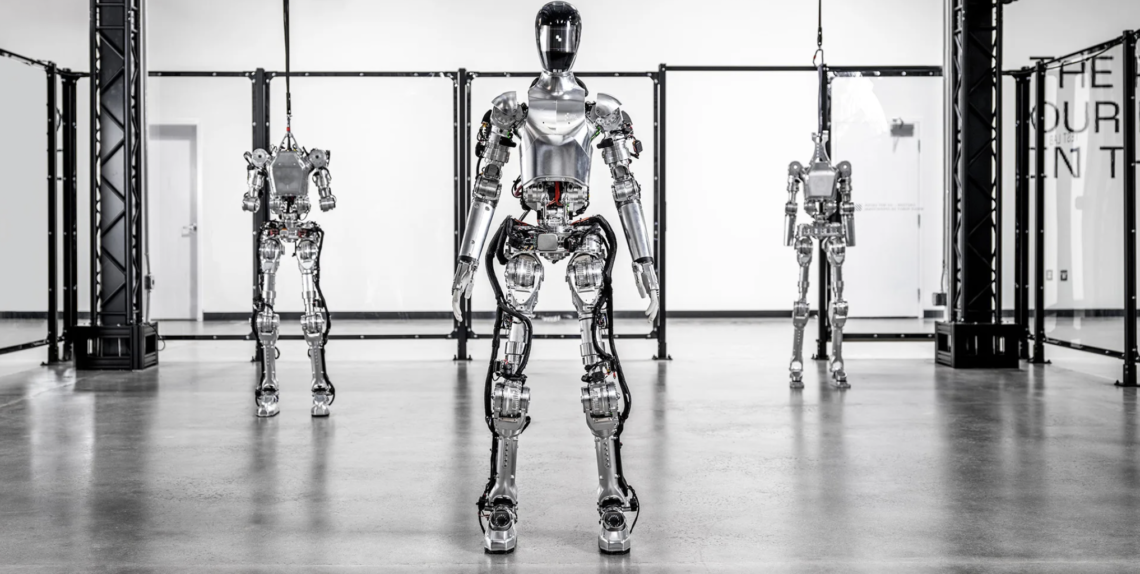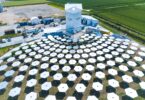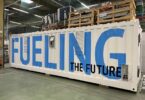The announcement this week that BMW will start using humanoid robots in one of its U.S. plants could herald a new kind of coexistence and cooperation between humans and robots; an interrelationship that pundits say is critical to the future of manufacturing and how robots interact physically in our work spaces.
Since the 1960s cartoon the Jetsons aired people have dreamed of being able to ask a robot to clean their homes or make dinner. While robots can vacuum and cook, we are still sometime away from wide-spread use of humanoid robots in the home. But If pundits are right 2024 may well be the year humanoid robots become a part of everyday life. More people will start interacting with them on the factory floor, requiring major organizational change and the upskilling of the global workforce.
California-based AI robotics company Figure’s commercial deal with BMW involves deploying general purpose robots in automotive manufacturing environments. Figure is developing autonomous general purpose humanoid robots that are designed for initial deployment into the workforce to address jobs that are undesirable or unsafe, and to support supply chain and manufacturing on a global scale.
“Single-purpose robotics have saturated the commercial market for decades, but the potential of general purpose robotics is completely untapped.,” Figure Founder and CEO Brett Adcock said in a statement. Figure’s robots (pictured here) “will enable companies to increase productivity, reduce costs, and create a safer and more consistent environment,” he said
It is just the beginning. In a January 16 post on X (formerly known as Twitter) Midjourney founder Dave Holz said “ we should be expecting a billion humanoid robots on earth in the 2040s and a hundred billion (mostly alien) robots throughout the solar system in the 2060s.”
Elon Musk, owner of X and founder of Tesla, publicly agreed with that estimate “providing civilization is stable at that time.” Tesla’s own humanoid robot, Tesla Optimus, also known as Tesla Bot, was first announced at the company’s AI Day even in August 2021. On an earnings call in January Musk said Tesla could begin shipping its Optimus humanoid robots as early as next year.
The Figure and Tesla announcements are not the only sign that more sophisticated robots are coming. In early January the Google DeepMind robotics team announced AutoRT, a system that harnesses the potential of AI large foundation models which are critical to creating robots that can understand practical human goals. “By collecting more experiential training data – and more diverse data – AutoRT can help scale robotic learning to better train robots for the real world,” the team said in a blog post.
AutoRT combines large foundation models such as a Large Language Model (LLM) or Visual Language Model (VLM), and a robot control model (RT-1 or RT-2) to create a system that can deploy robots to gather training data in novel environments, according to the blog post. AutoRT can simultaneously direct multiple robots, each equipped with a video camera and an end effector, to carry out diverse tasks in a range of settings. For each robot, the system uses a VLM to understand its environment and the objects within sight. Next, an LLM suggests a list of creative tasks that the robot could carry out, such as “Place the snack onto the countertop” and plays the role of decision-maker to select an appropriate task for the robot to carry out.
“In extensive real-world evaluations over seven months, the system safely orchestrated as many as 20 robots simultaneously, and up to 52 unique robots in total, in a variety of office buildings, gathering a diverse dataset comprising 77,000 robotic trials across 6,650 unique tasks,” the blog post said.
The Google DeepMind robotics team additionally introduced two other improvements that it says will make our robot allies more helpful. One, called Self -Adaptive Robust Attention for Robotics Transformers, seeks to help speed up robot decision making. The other, called RT-Trajectory, is aimed at helping robots understand tasks like wiping a table. Traditionally, training a robotic arm relies on mapping abstract natural language (“wipe the table”) to specific movements (close gripper, move left, move right), making it hard for models to generalize to novel tasks. Google’s RT-Trajectory model enables RT models to understand “how to do” tasks by interpreting specific robot motions like those contained in videos or sketches.
But the Google DeepMind robotics team acknowledges that before robots can be integrated into our everyday lives, they need to be developed responsibly with robust research demonstrating their real-world safety.
While AutoRT is a data-gathering system, it is also an early demonstration of autonomous robots for real-world use. It features safety guardrails, one of which is providing its LLM-based decision-maker with a Robot Constitution – a set of safety-focused prompts to abide by when selecting tasks for the robots. These rules are in part inspired by Isaac Asimov’s Three Laws of Robotics – first and foremost that a robot “may not injure a human being,” the Google DeepMind robotic team said in its blog post. Further safety rules require that no robot attempts tasks involving humans, animals, sharp objects or electrical appliances.
But even if large models are prompted correctly with self-critiquing, this alone cannot guarantee safety, says the robotics team. So the AutoRT system comprises layers of practical safety measures from classical robotics. For example, the collaborative robots are programmed to stop automatically if the force on its joints exceed a given threshold, and all active robots were kept in line-of-sight of a human supervisor with a physical deactivation switch.
Along with adopting ethics and safety requirements, the introduction of humanoid robots will require corporates to modify their business models to operate 24/7, change their supply chains and adapt their internal organization, Florence Verzelen, an executive vice-president at Dassault Systèmes, said in an interview with The Innovator. Scaling how humans and companies work with robots will be a major challenge, she says. “This requires knowing how to use the robots and what to do. A lot of people -especially blue collar workers- will have to adapt to the changes. Here good communication is essential. Otherwise, we risk social unrest like the social movement of British textile workers in the 19th century who organized in opposition to technological advances in technology.”
For more on human interaction with humanoid robots watch the video recording of a “Our Robot Allies” panel at the World Economic Forum in Davos moderated by The Innovator’s Editor-in-Chief.
IN OTHER NEWS THIS WEEK:
ARTIFICIAL INTELLIGENCE
Meta Announces Ambition To Build Artificial General Intelligence
In an Instagram post this week Meta Executive Chairman and CEO Mark Zuckerberg gave some updates on the company’s AI efforts. “Our long-term vision is to build general intelligence, open source it responsibly, and make it widely available so everyone can benefit,” he said.” We’re bringing our two major AI research efforts (FAIR and GenAI) closer together to support this. We’re currently training our next-gen model Llama 3, and we’re building massive compute infrastructure to support our future roadmap.”
U.S. National Science Foundation Launches Pilot To Further Development Of AI
The U.S. National Science Foundation on January 24 launched the National AI Research Resource (NAIRR) pilot to encourage greater participation in the technology’s development The pilot program will last two years and support 25-50 projects. NSF will provide computing power, data, software and training to researchers who will start by focusing on how to build trustworthy AI systems.Some resources, such as open data sets and models, will be automatically available on the NAIRR website, while access to computational systems will require an application.
Europe Introduces AI One Stop Shop Aimed At Startups
Europe’s startups will get easier access to artificial intelligence-dedicated supercomputers to help them develop general purpose AI models as part of a new one-stop shop to boost take up of the technology, the European Commission said on January 24. The Commission said the one-stop shop, or so-called AI Factories, would assist AI startups and researchers to develop algorithms, test and validate large-scale AI models, and facilitate their access to AI-dedicated supercomputers
MOBILITY
GM and Honda Begin Shipping Fuel Cell Power Systems
General Motors and Honda have begun shipping fuel cell power systems to customers from a factory near Detroit, they said January 25, a new test of whether hydrogen power technology can achieve mass-market success. Honda will use fuel cells in a version of its popular CR-V sport utility vehicle due to be unveiled in March, and they will also be included in other products including stationary power generators.The company and Japanese truck maker Isuzu are developing a hydrogen-fueled Class 8 semi truck. GM has previously announced plans to supply fuel cell systems to commercial truck maker Autocar under the Hydrotec brand.
To access more of The Innovator’s News In Context articles click here.






